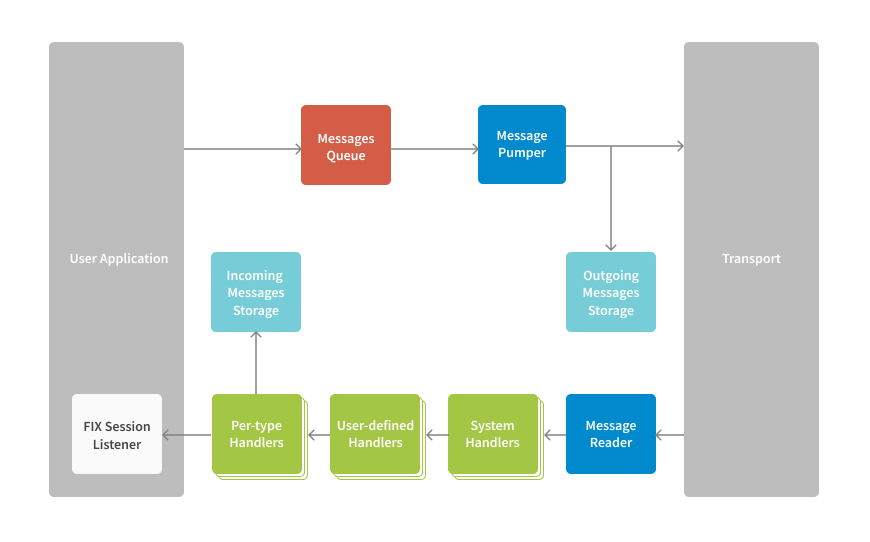FIX Antenna ®.NET Core allows developers to work with the latest Microsoft framework .NET Standard 2.0 (formal specification of API), which is supported by .NET Framework 4.8 and .NET 8.0). It helps strategically position a client's applications for the future. The FIX Antenna .NET Core engine is cross-platform, compatible with Windows and Linux platforms. The open source Community Edition is delivered via NuGet packages and GitHub repository.
FIX Antenna ®. NET Core benefits include the ability to generate structured messages and manipulate a message's content via an API. It is specifically designed to improve the productivity of .NET programmers, even if they are novice FIX users.
FIX Antenna .NET Core engine is cross-platform and is delivered as packages for Windows and Linux platforms. These packages are provided with samples to ensure an easy start and a fast learning curve for users. Furthermore, FIX Antenna .NET Core comes with a rich UI for monitoring session statuses and parameters in real time on desktop app or web browser.
FIX Antenna ® .NET Core supports FIX 4.0, 4.1, 4.2, 4.3, 4.4, 5.0, 5.0 SP1, 5.0 SP2, FIXLatest. Our products come with 24x7 support provided worldwide and availability of "on-demand" software escrow.
Features
| Feature | Description |
|---|---|
| High performance / low latency | FIX Antenna .NET Core adds about 19.5 microseconds latency (with 99 percentile) in the Round-Trip scenario. See details on the Benchmarks page. |
| Supports standard FIX |
|
| Delivery modes |
|
| Highly customizable FIX session level |
|
| Reliability and redundancy |
|
| Security |
|
| Performance tuning |
|
| Configuration |
|
| Monitoring and administration |
|
| Message composition API |
|
| Integration |
|
| Storage |
|
| Packaging |
The package includes:
|
Architecture
FIX Antenna .NET Core follows FIX Antenna Java architectural principles proved by long-term usage.
The transport layer of FIX Antenna .NET Core is similar to FIX Antenna Java and uses message queues. Using queues is helpful when working in high-load scenarios.
The FIX session layer uses a Chain of Responsibility pattern. The system and user defined handler chains are used for tasks such as message validation, sequence number handling, etc. Custom logic could be incorporated into different places in this chain; it enables greater flexibility and helps adapt an application's behavior to different requirements.
If a session is persistent messages are stored after processing. Incoming messages are stored when the normal processing by all handlers and the user application is finished, while outgoing messages are stored right after they are sent to counterparties.
APIs
FIX Antenna .NET Core provides the following main APIs for trading applications to:
- Create multiple FIX sessions (initiators and acceptors)
- Open and close FIX sessions
- Schedule start and stop operations for FIX sessions
- Form FIX messages
- Validate FIX messages
- Send and receive FIX messages
- Set sequence numbers
- Conveniently handle repeating groups in FIX messages
Samples
| Name | Description |
|---|---|
| SimpleAdminClient | Demonstrates how to connect to an administrative session and communicate with it using the implementation of administrative messages. |
| SimpleServer | Demonstrates how to implement a FIX server with simple IP filtering of incoming sessions. |
| EchoServer | Demonstrates a very simple server that sends all received messages back to a client. |
| ConnectToGateway | Demonstrates a very simple client that connects to the server and accepts all received messages. |
| runClientRoundTripLatencyBM and runServerRoundTripLatencyBM | Measure Round trip time benchmarks. |
Pricing Overview
We provide cost-effective perpetual and annual licensing options that are tailored specifically to meet your operational needs. These models are customized based on your preferred support level (ranging from business hours to 24x5/7 coverage with varying Service Level Agreements (SLA)), the number of machines required, and your specific deployment environment. Licenses for non-production environments, such as development, testing, and backup, are offered separately at 50% of the cost of a production license.
view licensing models·